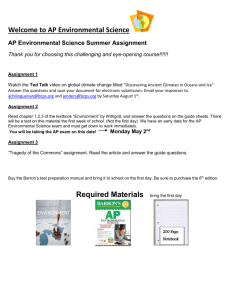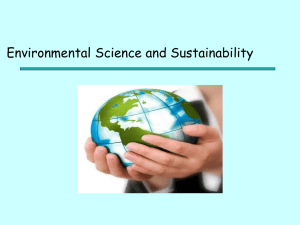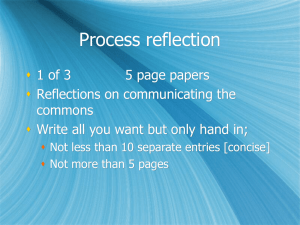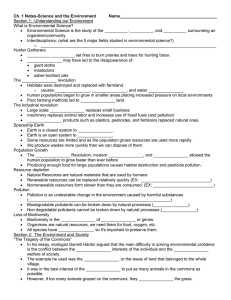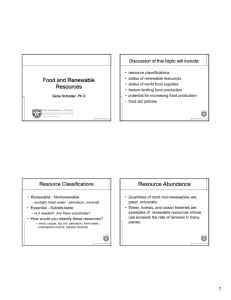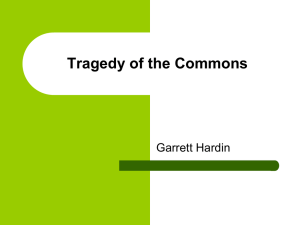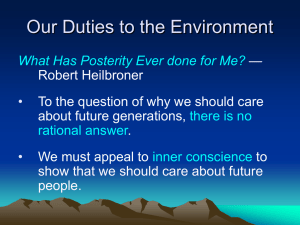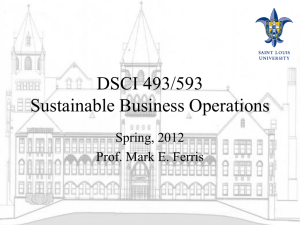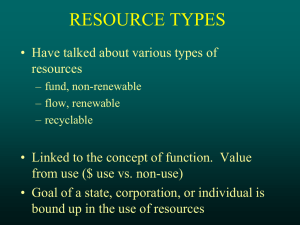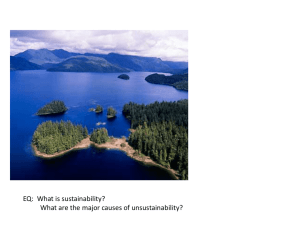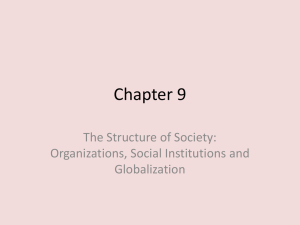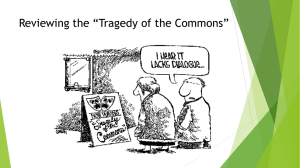The Tragedy of the Commons Analysis Questions
advertisement
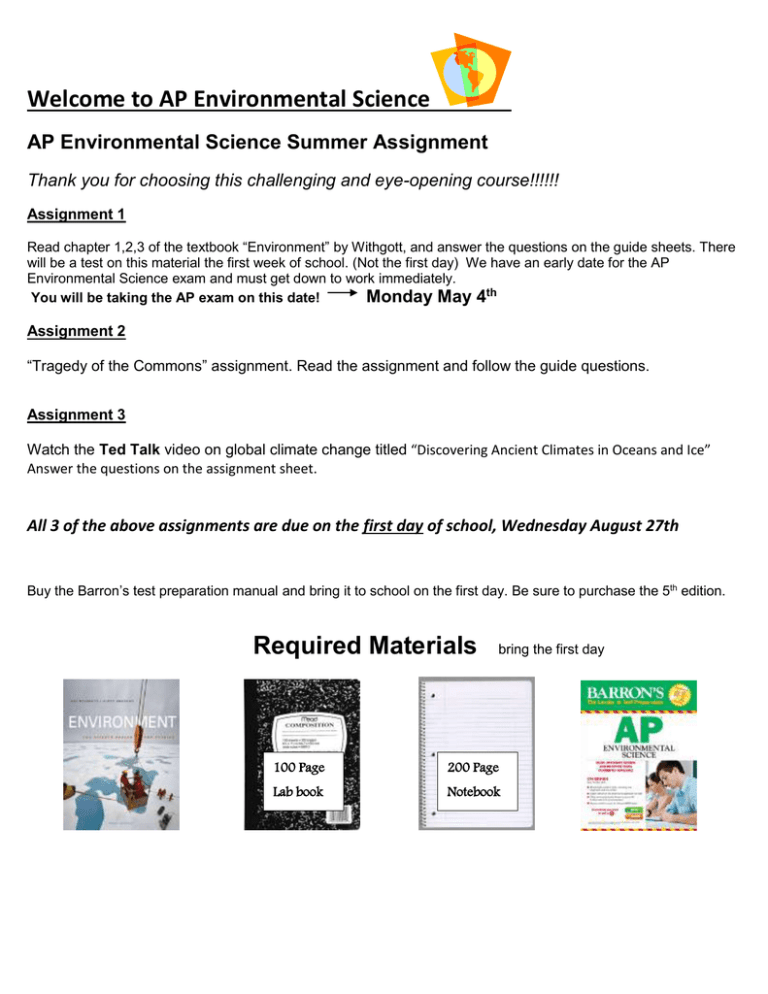
Welcome to AP Environmental Science AP Environmental Science Summer Assignment Thank you for choosing this challenging and eye-opening course!!!!!! Assignment 1 Read chapter 1,2,3 of the textbook “Environment” by Withgott, and answer the questions on the guide sheets. There will be a test on this material the first week of school. (Not the first day) We have an early date for the AP Environmental Science exam and must get down to work immediately. You will be taking the AP exam on this date! Monday May 4th Assignment 2 “Tragedy of the Commons” assignment. Read the assignment and follow the guide questions. Assignment 3 Watch the Ted Talk video on global climate change titled “Discovering Ancient Climates in Oceans and Ice” Answer the questions on the assignment sheet. All 3 of the above assignments are due on the first day of school, Wednesday August 27th Buy the Barron’s test preparation manual and bring it to school on the first day. Be sure to purchase the 5th edition. Required Materials bring the first day 100 Page 200 Page Lab book Notebook Assignment 1 Chapter 1-3 Guided Reading Read Chapters 1-3 from your textbook and answer the following questions using complete sentences. Chapter 1 1. Many resources are renewable if we use them in moderation but can become nonrenewable if we overexploit them. Order the following resources on a continuum of renewability (see Figure 1.1), from most renewable to least renewable: soils, timber, fresh water, food crops, and biodiversity. What factors influenced your decision? For each of these resources, what might constitute over-exploitation, and what might constitute sustainable use? 2. Describe the impact of the agricultural and industrial revolutions on the human population and the environment. Be sure to include the impact on population size, way of life, and environmental changes. 3. Visit http://footprintnetwork.org/en/index.php/GFN/page/calculators/ and complete the activity. a. Fill in the blanks. To support your lifestyle, it takes ________ global acres of the Earth’s productive area. (____ tons of carbon dioxide) b. How does your Ecological Footprint break down? Hover over each portion of the pie graph and record the percent that you use for each section. c. What is an ecological footprint? 4. Why do you think the Easter Islanders did not or could not stop themselves from stripping their island of all its trees? Do you see similarities between the history of the Easter Islanders and the modern history of our society? Why or why not? 5. What is sustainable development, and why is it important? What is meant by “triple bottom line”? Refer to p 23 Interpreting Graphs and Data to complete the next two problems. 6. (p24 #1) Using the graph in part (a), what would you say was the population size after 200 generations? After 600? After 800? How would you answer the same questions using the graph in part (b)? 7. (p24#3) What advantages and disadvantages might there be in using a linear graph like the one in part (a)? What advantages and disadvantages might there be in using a logarithmic graph like the one in part (b)? What types of data would be clarified by each type of graph, and what types would be left unclear? Chapter 2 1. Summarize the issue, perspectives, and actions of the Mirrar Clan and Rio Tinto in regards to the Jabiluka Mine. Is the perspective of the Mirrar Clan anthropocentric, biocentric, or ecocentric? Explain your answer. 2. (pp53-54 #3) How would you analyze the case of the Mirrar Clan and the proposed Jabiluka uranium mine from each of the following perspectives? In your description, list at least one question that a person of each perspective would likely ask when attempting to decide whether the mine should be developed. Be as specific as possible, and be sure to identify similarities and differences in approaches: a. Preservationist d. Environmental justice advocate b. Conservationist e. Neoclassical economist c. Deep ecologist f. Ecological economist 3. (p54 #6) A manufacturing facility on a river near your home provides jobs for 200 people in your community and pays $2 million in taxes to the local government each year. Sales taxes from purchases made by plant employees and their families contribute an additional $1 million to local government coffers. However, newspaper reports and recent peer-reviewed studies in wellrespected scientific journals reveal that the plant has been discharging large amounts of waste into the river, causing a 25% increase in cancer rates, a 30% reduction in riverfront property values, and a 75% decrease in native fish populations. The plant owner says the facility can stay in business only because there are no regulations mandating expensive treatment of waste from the plant. If any such regulations were imposed, he says he would close the plant, lay off its employees, and relocate to a more business friendly community. How would you recommend resolving this situation? What further information would you want to know before making a recommendation? In arriving at your recommendation, how did you weigh the costs and benefits associated with each of the plant’s impacts? 4. Describe a cost-benefit analysis approach to economics. Explain when an action should and should not be pursued. What are drawbacks to the cost-benefit analysis approach as it relates to environmental science. 5. Four fundamental assumptions of neoclassical economics have implications for the environment. Based on your reading, discuss each of the four assumptions by answering the following questions. (Use details from the text to support your answers). a. Are resources infinite or substitutable? b. Are costs and benefits internal? c. Should long terms effects be discounted? d. Is growth good? 6. Compare and contrast the following terms: a. Classic supply-demand curve vs. Marginal benefit and cost curve b. Economic growth vs. Sustainability c. GDP vs. GPI Chapter 3 1. 2. 3. 4. 5. 6. 7. 8. 9. 10. Read the entire chapter. Summarize the issue with the Tijuana River and sewage pollution. What is public policy? Describe the free rider predicament and explain why it suggests a need for public policy. What is environmental policy? Describe how external costs suggest a need for environmental policy. Briefly describe the incidents on the Cuyahoga River near Cleveland, Ohio. Now, imagine you are the judge presiding over a lawsuit brought by citizens who live next to an industrial plant. Pollution from the plant regularly covers their homes, yards, and cars with soot, making the people cough and wheeze. In weighing whether to require the plant to clean up its emissions, will you consider in your ruling the financial costs the factory would need to incur? Or will you ignore economic aspects and base your ruling solely on evidence of harm to health? Give reasons for your answer. Describe the role of the Environmental Protection Agency (EPA). Summarize the following environmental acts: a. National Environmental Policy Act (NEPA) b. Clean Air Act (see p 482) c. Clean Water Act Describe the "command and control" approach to environmental policy. Summarize the following international environmental agreements: a. Kyoto Protocol b. Montreal Protocol Define environmental impact statement (EIS), executive branch, green tax, judicial branch, legislative branch, lobbying, regulations, and subsidy. If Nation A has stricter laws for environmental protection than Nation B, and if these laws restrict the ability of Nation B to export its goods to Nation A, then by the policy of the WTO and the EU, Nation A’s environmental protection laws could be overruled in the name of free trade. Do you think this is right? What if Nation A is a wealthy industrialized country and Nation B is a poor developing country that needs every economic boost it can get? Assignment 2 The Tragedy of the Commons Analysis Questions Go to http://www.sciencemag.org/content/162/3859/1243.full and read the Tragedy of the Commons by Garrett Hardin and answer the following questions using complete sentences. Science 13 December 1968: Vol. 162 no. 3859 pp. 1243-1248 1. 2. 3. 4. 5. 6. 7. 8. 9. 10. 11. 12. Explain the analogy the author makes between the population problem and a game. According to the author, is ours a finite world? Explain. What is Bentham’s goal? How does the author feel about reaching this goal? What are incommensurables? What is the criterion in nature? Explain Adam Smith’s idea of the “invisible hand” and what does this say about human selfishness? Explain the author’s analogy about the herdsman, personal gain, and what happens to freedom in a commons; the “philosophy of the commons”. How is pollution the “reverse” tragedy of the commons? What did the United Nations declare in 1967? Why does Garrett Hardin find fault with it? What did Charles Galton Darwin (Darwin’s grandson) explain about the self-eliminating nature of conscience? What example does the author give for “mutual coercion mutually agreed upon”? What is Hegel’s quote about freedom? With what plea does Hardin end his essay “The Tragedy of the Commons”? Explain how each of these scenarios is or is not an example of Tragedy of the Commons: a. When North America was settled, forests covered the land. People cut them down for wood and to clear land for farms. b. Blackberries are growing in a public park. They are sweetest when they are black. People walking through the park pick the black ones first and then go on to pick red ones, not waiting for the black ones to ripen. c. Weyerhauser, a paper company, owns a forest where it cuts trees for its paper products. It clearcuts huge areas of forest, leaving them desolate and naked of vegetation. d. About 10,000 years ago, many great mammals lived in North America, including saber-toothed cats, dire wolves, and mammoths. They went extinct as a result of hunting by Paleo-Indians. e. The air over Mexico City is heavily polluted by many unregulated factories and heavy traffic. Assignment 3 Discovering Ancient Climates in Oceans and Ice (18 min) Go to: http://www.ted.com/talks/rob_dunbar Please watch the video once with no disruption, then go back and watch it again and answer the questions. Answer these questions hand written neatly on a separate sheet of notebook paper. Self Evaluation: Directions: place the grade value next to each question to evaluate your performance. Quality…… Excellent A Good B Fair C Needs improvement D Incomplete E Example: Grade you give yourself 1. ___B___ Here is your response to the question. Write your grade next to the number. Read the question carefully. 1. Where was this video recorded, and what is the significance of this place to the scientific community? 2. What does Rob Dunbar say about CO2 concentrations? Be sure to discuss what PPM means and how CO2 enters the atmosphere. 3. Describe the 4 natural causes of climate change. Go beyond what is said in the video. Do some research on your own. 4. What are the three human induced causes of climate change? Explain thoroughly and research further. 5. The earth science term for reflectivity is ____________________________________. (word not used in the video) 6. Describe the research conducted in Antarctica to study global climate change. 7. What caused the sea level to rise and fall by 6 meters many times in the past? 8. Describe the research conducted on coral and how it tells us about past climate. Describe coral bleaching as a function of CO2.
